The Red-tailed Hawk (Buteo jamaicensis) is a magnificent bird of prey that captivates the imagination with its soaring flights and piercing gaze. Known for its widespread distribution across North America, the Red-tailed Hawk is often associated with its distinctive vocalizations, which are an integral part of its communication and territorial behavior. In this article, we will delve into the captivating sounds of the Red-tailed Hawk and explore the significance behind its vocal repertoire.
Description of the Red-tailed Hawk’s Call:
The vocalizations of the Red-tailed Hawk can be described as powerful, high-pitched, and sharp. The bird emits a variety of calls, each serving a different purpose in its social and territorial interactions. The most iconic and well-known call of the Red-tailed Hawk is often described as a “kee-eeeee-ar” or “keeeer” sound. This call is primarily associated with the bird’s courtship displays and is typically delivered by the male during aerial acrobatics.
Additionally, Red-tailed Hawks emit a range of other vocalizations. Their alarm call is a short, high-pitched “kreee” or “kyeeeek” sound that serves to warn other hawks of potential danger or threats. This vocalization is often accompanied by defensive behaviors, such as dive-bombing or soaring high above the intruder.
Furthermore, the Red-tailed Hawk is known to produce a piercing, descending scream, commonly referred to as the “screech.” This vocalization is often associated with aggressive encounters or territorial disputes between individuals. The screech is a powerful and intimidating call, meant to assert dominance and establish boundaries within their habitat.
Function and Significance of Vocalizations:
Vocalizations play a crucial role in the communication and social dynamics of the Red-tailed Hawk. These calls serve several functions, including territorial defense, courtship, and maintaining social bonds.
Territorial Defense: The Red-tailed Hawk’s calls are essential for establishing and defending its territory. By emitting their characteristic scream or alarm calls, hawks can communicate their presence and deter potential intruders from encroaching upon their breeding grounds or hunting areas.
Courtship Displays: During the breeding season, the male Red-tailed Hawk utilizes its distinctive call to attract a mate. The courtship display includes aerial acrobatics and impressive flight maneuvers, accompanied by the male’s melodious “kee-eeeee-ar” call. This call not only demonstrates the male’s physical prowess but also serves as an invitation for the female to join in the elaborate courtship ritual.
Maintaining Social Bonds: Vocalizations also help Red-tailed Hawks maintain social connections within their family units. Nestlings and adults engage in vocal exchanges, contributing to bonding and coordination during hunting or other cooperative activities.
Conclusion:
The vocalizations of the Red-tailed Hawk are awe-inspiring and play a vital role in their survival and social interactions. From their distinctive “kee-eeeee-ar” call during courtship to the piercing screeches used in territorial disputes, these majestic birds effectively communicate their presence and intentions to others.
Understanding the significance of the Red-tailed Hawk’s vocal repertoire provides us with a glimpse into their intricate social lives and their ability to navigate and establish dominance within their habitats. The captivating sounds of the Red-tailed Hawk remind us of the rich diversity of nature and the importance of conserving these remarkable birds of prey for future generations to enjoy.


 Facebook
Facebook  Instagram
Instagram  Youtube
Youtube 